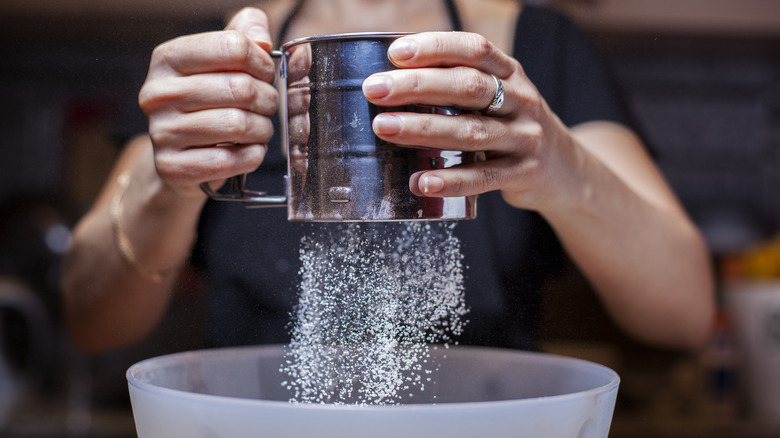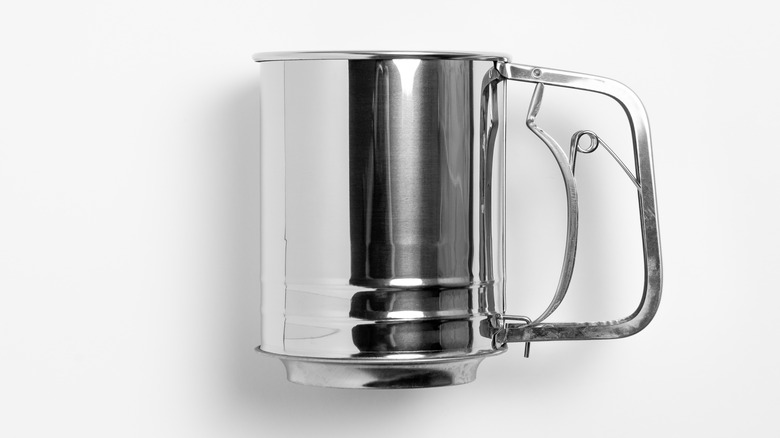How You Should Be Cleaning Your Flour Sifter
When it comes to cleaning your flour sifter, failure is not an option, as anyone who has cut corners during the cleanup process knows. Doing so means the tool can grip chunks of calcified dry ingredients and drop them haphazardly into your next batter. It's a frustrating — but thankfully, avoidable — experience.
The solution is not to simply ditch the specialized baking equipment. In fact, professionals bakers like Duff Goldman would urge you never to skip this step. A flour sifter serves a niche but helpful role in aerating desserts into fluffy treats and removing offending clumps of baking powder and cocoa. It ensures smooth batter without much effort.
That's why it pays to learn how to clean a flour sifter, particularly before it goes anywhere near water, which can cause those stubborn caked-on pieces. First, flip the sifter over a trash can and shake out any remaining flour you can. Next, take a pastry brush and use it to knock off remaining powder. For truly hard-to-reach spots, some bakers reach for compressed air, but it's not recommended, as the cans contain other gasses that are not necessarily food-safe. For added power, reach for a hair dryer if your other dusters aren't cutting it to remove debris.
Washing your sifter is important
There may be a temptation to not wet or to not wash your sifter, especially since it stays dry and works with roughly the same ingredients each time. However, not washing it properly can introduce unwanted ingredients from your last bake into future mixtures. Suddenly those deep-fried coke bites will have flecks of cocoa and salt from when you made fudgy macadamia and peanut butter brownies.
That's why, after a thorough dusting, you'll want to wash the strainer in warm water with a little dish soap. Although some manufacturers deem their tools dishwasher-safe, cleaning it by hand allows for more control and quicker drying. The risk in leaving the metal to soak or slowly dry is that it will rust and may need to be replaced.
If you're a baker on-the-go and unable to dry the cleaned equipment thoroughly, consider switching to a newer model with a body made of plastic. You can also switch to a sieve to filter dry ingredients, but many cooks prefer the convenience and control of the small tool and its agitator, which can break down some clumps. Mesh strainers are up to the task but can cause flour to fall outside the bowl or require a lot of slow shaking to sift through cups of flour.
More kitchen and house tasks can be done with a clean sifter
Once you've got the hang of washing your flour sifter, consider repurposing it for other tasks both inside and outside of the kitchen. The shape allows for neat and more equal distribution of ingredients, which means it's a helpful tool when dusting bannetons with rice flour during the sourdough-making process. It can also be used to coat finished bakes with a layer of powdered sugar, though we recommend covering your workspace to catch any rogue pieces.
Cooks reluctant to dirty hands can pour finely ground rubs and spice blends through the sifter to spread across proteins before cooking. However, those flavors will linger without a good scrub, so make sure to be meticulous about washing the sifter after. Hosts can also use the sifters to neaten up condiments, for example, filtering out pesky clumps when refilling the sugar bowl or the salt shaker.
The fine mesh is perfect for filtering baking soda — so try using it to help with other projects that use the ingredient, like deodorizing well-loved carpets. To do so, slowly pour the bicarbonate into the sifter and sprinkle it evenly across the surface of rugs, sofas, and other smelly fabrics. Again, products will spread evenly, as opposed to dumping out in thin lines from the box or shaker. For added stain or odor-removing power, you can follow this move with a spritz of water or diluted white vinegar to activate the product, then let it sit before vacuuming it away.



